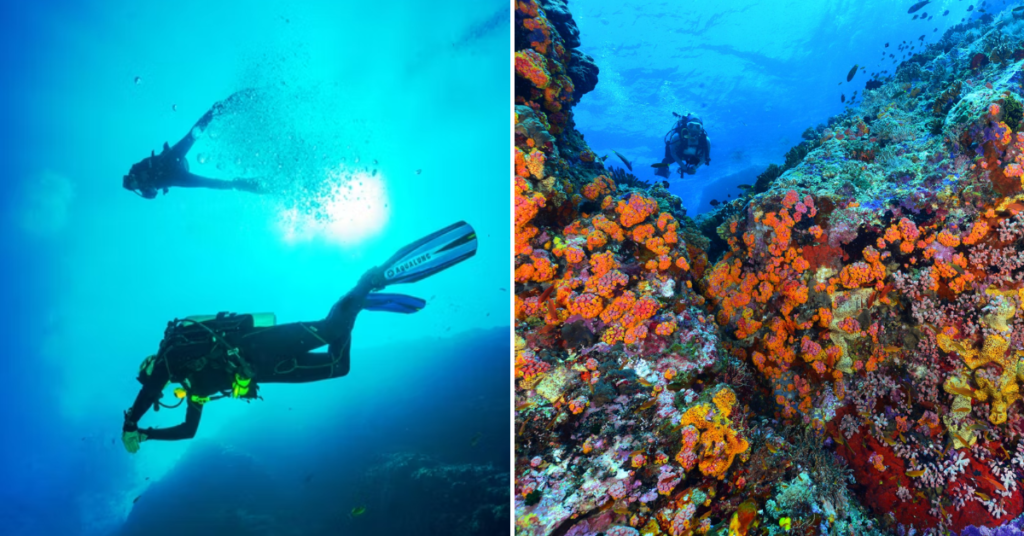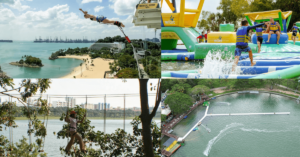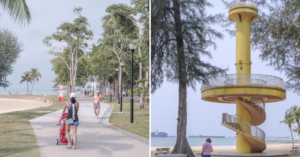The Philippines has over 7,000 magnificent islands and many more lovely beaches, some of which are regarded to be among the greatest in the world. But this Southeast Asian country has more to offer than its picturesque islands and beaches. Swimming with thresher sharks in Cebu, exploring World War II wreckage in Palawan, and finding a UNESCO World Heritage Site in Puerto Princesa are just a few of the wonderful views and experiences you may have when scuba diving in the Philippines. With that, here is Glitz’s guide to seeing Philippines marine life in the best way possible at these scuba diving sites!
1. Tubbataha Reefs Natural Park
Contents
The Tubbataha Reefs Natural Park, located in the southwestern section of Puerto Princesa, Palawan, and at the centre of The Coral Triangle, is the Philippines’ crown treasure. “Tubbataha” is a Samal word that translates to “long reef exposed at low tide.” Tubbataha diving allows you to explore two massive coral atolls known as the North and South Atolls, as well as a smaller coral structure known as the Jessie Beazley Reef, which is located northeast of the North Atoll.
Its position inherently isolates it, which has proven to be its strongest defence against human exploitation. Most, if not all, diving liveaboards set sail from Puerto Princesa’s port in the evening and arrive at Tubbataha by morning. Tubbataha is the Philippines’ first national marine park, and it has achieved several milestones over the years due to the efforts of dedicated conservationists, scientists, and scuba divers.
It is a UNESCO World Heritage Site and a Ramsar Wetlands of International Importance, and it is one of the country’s major Marine Protected Areas. You’ll be able to observe 360 different coral species, which is half of what the planet has now, as well as 23 different shark and ray species!
2. Verde Island Passage
The San Agapito diving site resembles a seamount with three peaks, one of which is always visible out of the water around 2 metres above the surface, depending on the tides. The depth of the third pinnacle is 18 metres. The island is located in the middle of the famed Verde Island Passage, a 1.14-million-hectare strait. In this stretch of the Verde Island Passage, the current is particularly strong. As a result, only experienced advanced scuba divers are permitted to dive here.
You might dive either the east or west side of the sea mount depending on the direction of the water. Huge coral fans may be found as you descend. Juvenile sea turtles go through the motions of feeding, breaching, swimming, and resting on a regular basis. You’ll also see a school of jacks and mackerels, as well as families of giant tunas and groupers prowling around, exactly like on regular scuba diving expeditions.
3. Anilao
Anilao diving in Batangas, often known as the Philippines’ Nudibranch Capital, is the closest underwater paradise to Metro Manila. It takes 2.5 to 3 hours by automobile to go between the numerous access points in Anilao from Manila. It boasts a massive cove with around 60 diving opportunities for anybody to enjoy.
Anilao technically refers to two barangays or towns in the municipality of Mabini, Batangas (Anilao Proper and Anilao East). Anilao became the popular phrase to designate all dive sites found in Mabini, Tingloy, and Bauan since it was where the harbour was located and the only possible entry point for scuba diving 40 years ago. When attending an Anilao diving tour, you have three options: explore the little exotic species it hides, immerse yourself in its abundant biodiversity, or go blackwater diving.
4. Balicasag Island
When visiting Panglao Island in Bohol, diving on Balicasag Island is a must. Whether you just want to enjoy the beach or do scuba diving, you’ll need to organise boats from Panglao Island to travel to Balicasag Island. Balicasag Island is a marine sanctuary with a diameter of around 600 metres. When island hopping in the Philippines, it is one of the greatest places to visit.
It is surrounded by five outstanding diving sites, including the Balicasag Marine Sanctuary, which features a 200-metre drop-off. It’s a fantastic site to visit, especially when you consider the visibility, which varies from 20 to 30 metres depending on the season. The most famous diving location, the Black Forest, received its name from the quantity of beautiful black corals. As the name implies, Turtle Point is home to the largest number of friendly resident sea turtles with whom you may go diving.
Always approach slowly to demonstrate that you mean no harm, and never touch any of them, especially aquatic life. There are further caverns that are 60 to 75 metres deep and are only accessible to technical divers.
5. Malapascua
The pelagic thresher sharks are the highlight of Malapascua diving in Cebu. Thresher sharks are deep-sea sharks that spend most of their time submerged. Take note, however, that only at Malapascua do they go shallow enough for divers to witness on virtually a daily basis amid recreational diving depths. A submerged plateau named Monad Shoal off the south-eastern edge of Malapascua Island is home to an abundance of cleaner wrasse fish.
Thresher sharks may use these fish to clean their body for free, removing parasites and decaying tissues. The picturesque Gato Island, a sea snake and a fish sanctuary are located off the north-eastern coast of Malapascua Island. It has a large cave on the southwestern side of the island that is about 12 metres deep and 20 to 25 metres long.
Apart from diving, take a stroll along Bounty Beach, which is lined with restaurants and stores. If you enjoy viewing sunsets, Logon Beach is the perfect place to go.
6. Dauin
Dauin is a tiny seaside hamlet in the south-eastern section of Negros Oriental, near Dumaguete. Sibulan Airport, commonly known as Dumaguete Airport, is the closest airport. There are 18 popular muck diving dive spots along the coastline. Some of the creatures discovered when diving in Dauin are really unusual.
If you’re unfamiliar with muck diving, it simply implies that the majority of the region is sandy. However, you’ll need to be cunning to spot these animals hidden right beneath your nose, since they utilise fantastic camouflage strategies that are unique to this area.
The diving locations are mainly sloping down from the beach to depths of up to 30 metres. There are car wrecks, artificial reefs formed of tyre treads, sea grass, sandy spots, and rock formations where many species can be found. Dauin is the most common launching point for trips to Apo Island, which is famed for its diver-friendly sea turtles and a large school of jacks.


















